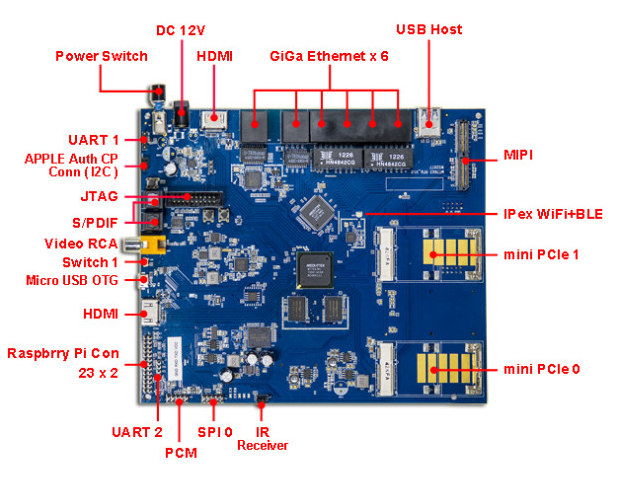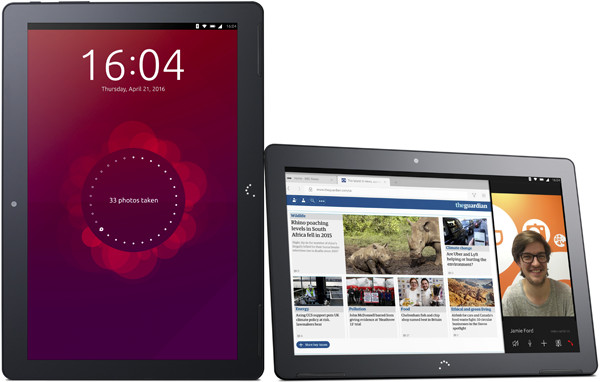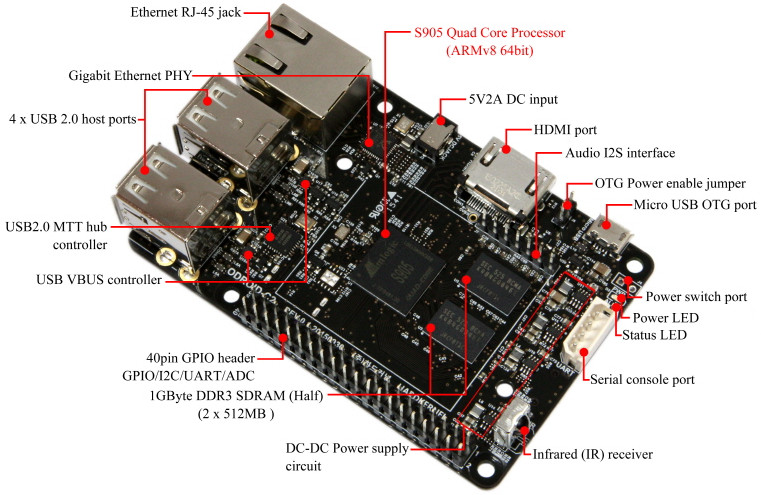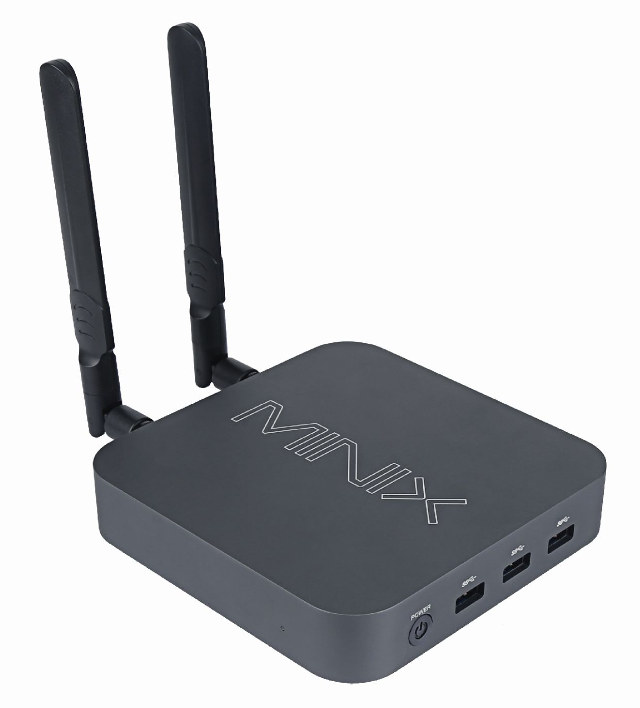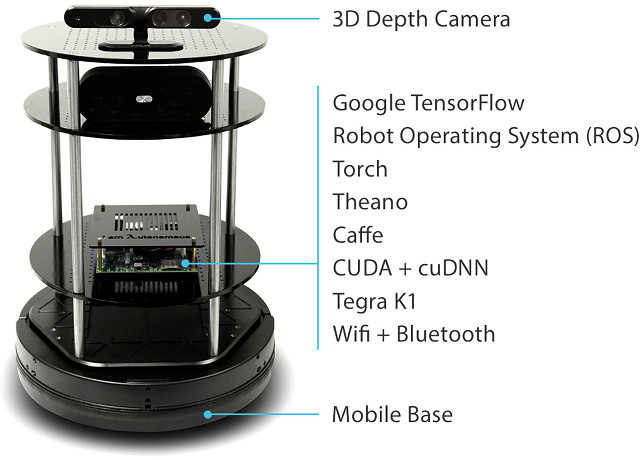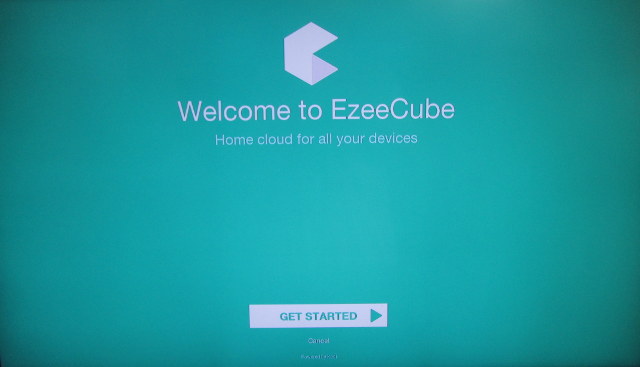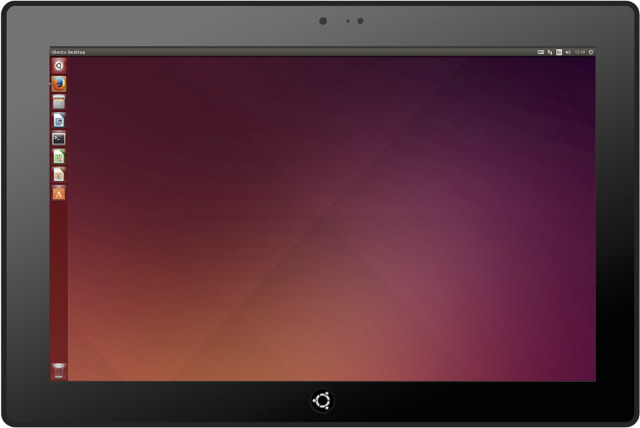We’ve seen a few interesting and relatively powerful router board launched last year, with the likes of MQMaker WiTi or Turris Omnia, AsiaRF has now designed Geek Force board powered by Mediatek MT7623N/MT7623A quad core network processor combined with 2GB RAM, six Gigabit Ethernet ports, and optional 802.11ac and 3G connectivity via the three mPCIe slots available on the board. The board also features two HDMI ports, and supports multimedia capabilities such as H.264, MPEG-2, or VC-1 hardware video decoding. Geek Force board preliminary specifications: SoC – MediaTek MT7623A or MT7623N quad-core ARM Cotex-A7 @ 1.3GHz with Mali-450MP GPU (MT7623N only) System Memory – 2GB DDR3 Storage – 2GB eMMC or NAND Flash + SD card slot up to 128 GB, and maybe SATA via the mPCIe slots Connectivity – 6 Gigabit Ethernet ports (WAN / LAN behavior defined by firmware), 802.11 b/g/n WiFi & Bluetooth 4.0 via MT6625L with […]
BQ Aquaris M10 Ubuntu Edition Tablet is the First Ubuntu “Convergence” Device
Three years ago, Canonical unveiled their plan to develop Ubuntu for Tablets with support for both tablet mode and full desktop convergence, but development took longer than expected, and in the meantimes some companies launched tablets without real mobile / desktop convergence, such as Cube i7-CM or Mastermind UT One, non of which were really successful. However, with the upcoming Ubuntu 16.04 “Xenial Xerus” LTS release, Canonical has worked it out, and the company cooperated with BQ to develop Aquaris M10 Ubuntu Edition tablet the feature both mobile and desktop modes. BQ Aquaris M10 Ubuntu edition specifications: SoC – MediaTek MT8163A ARM Cortex-A53 quad-core processor @ 1.5 GHz with ARM Mali-T720MP2 GPU System Memory – 2GB RAM Storage – 16GB storage + microSD card slot for up to 64GB of removable storage Display – 10.1″ multitouch screen; 1920×1200 resolution Video Output – micro HDMI output Audio – Frontal speakers, 3.5mm […]
Hardkernel ODROID-C2 64-Bit ARM Development Board to Sell for $40 Next Month
We previously knew ODROID-C2 was in development thanks to a document and source code from Amlogic themselves. We did not have the full details at the time, and Amlogic’s document even got the RAM capacity wrong. Hardkernel has finally announced ODROID-C2 development board based on Amlogic S905 will be selling on March 2016 for $40, and released specifications and some photos. ODROID-C2 specifications: SoC – Amlogic S905 quad core cortex-A53 processor with 3+2 cores Mali-450 GPU System Memory – 2GB DDR3 SDRAM Storage – eMMC module socket with 8, 16, 32, or 64GB module by Toshiba or Sandisk + micro SD slot supporting UHS-1 SD cards. Video Output – HDMI 2.0 Connectivity – Gigabit Ethernet (Realtek RTL8211F) USB – 4x USB 2.0 host ports + micro USB OTG port Expansion Header 40-pin header with GPIO, I2C, UART, and ADC ; All I/Os are 3.3V, except ADC that is limited to […]
MINIX NGC-1 Braswell Mini PC Runs Windows 10 or Ubuntu
MINIX showcased some unnamed Braswell mini PCs at IFA 2015 last September, but since then the company has been pretty quiet about their new Intel based mini PCs. The good news is that MINIX NGC-1 will be launched in about two weeks with an Intel Celeron N3150 quad core “Braswell” processor coupled with 4GB RAM, and 128GB M.2 SSD, and beside running Windows 10 64-bit, it will also support Ubuntu. MINIX NGC-1 specifications: SoC – Intel Celeron N3150 quad-core processor @ 1.6 GHz / 2.08 GHz (Turbo) with 2MB L2 cache, and Intel HD graphics with 12EU (4W SDP / 6W TDP) System Memory – 4GB DDR3L Storage – 128 M.2 SSD Video Output – HDMI 1.4 up to 4K @ 30 Hz, and mini DisplayPort Audio I/O – HDMI, 3.5mm stereo jack (microphone + headphone), and optical S/PDIF Connectivity – Gigabit Ethernet, 802.11ac WiFi and Bluetooth 4.2 with two […]
Autonomous Deep Learning Robot Features Nvidia Jetson TK1 Board, a 3D Camera, and More
Autonomous, a US company that makes smart products such as smart desks, virtual reality kits and autonomous robots, has recently introduced a deep learning robot that comes with a 3D camera, speaker and microphone, Jetson TK1 board, and a mobile base. The robot appears to be mostly made of the shelves parts: 3D Depth camera – Asus Xtion Pro 3D Depth Camera Speaker & Microphone Nvidia Jetson TK1 PM375 board – Nvidia Terra K1 quad-core Cortex A15 processor @ 2.3 GHz with a 192-core Kepler GPU, 2GB RAM, 16 GB flash Kobuki Mobile Base – Kobuki is the best mobile base designed for education and research on state of the art robotics. Kobuki provides power supplies for external computer power as well as additional sensors and actuators. Its highly accurate odometry, amended by calibrated gyroscope, enables precise navigation. The robot is designed for research in deep learning and mobile robotics, […]
Review of EzeeCube Media Hub and Private Cloud Server
EzeeCube is a Linux Kodi based media hub powered by Freescale i.MX6 Quad processor that includes a 1 or 2 TB hard drive by default and is expandable with extra 2TB hard drive modules that you simply stack on top of each other to get up to 10TB storage. I had a look at EzeeCube hardware last October, but due to one issue with the Android app that prevents syncing pictures between my phone and the hard drive on the device, one of the key selling point of the system, I decided to postpone the review. EzeeCube developers finally found a workaround in early December, but as I was busy with other tasks and the end of year holidays, I only managed to finally review the device in the last few days. Initial Setup The first thing that you go through after connecting all cables, and powering up the media […]
MJ Technology Ubuntu 16.04 Tablets are Powered by Intel Atom x7-Z8700 Processor
A company called MJ Technology is planning to launch Ubuntu tablets powered by an Intel Atom x7 Cherry Trail quad core processor with 4GB RAM, 64 GB RAM, and 8.9″ or 10.1″ full HD displays. MJ Tech Ubuntu tablets specifications: SoC – Intel Atom x7-Z8700 quad core processor up to 2.40 GHz with Intel HD Gen8 graphics System Memory – 4GB LPDDR3 RAM (2x2GB) Storage – 64GB Internal + micro SD Slot up to 128GB Display – 8.9″ and 10.1″ HD IPS display (1920×1200) with 10 point multi-touch Video Output – micro HDMI Audio – HDMI, 3.5mm headphone jack, and 2x 2W speakers Connectivity – Dual band 802.11 a/b/g/n WiFi and Bluetooth 4.0 USB – 1 x USB 2.0 host port, 1x USB 3.0 host port, 1 x micro USB port Camera – 8MP front facing camera, and 13MP rear camera Expansion – Internal mini PCI-Express slot with external access […]
AMD Launches 3 ARM based Opteron A1100 Server SoCs: A1120, A1150 and A1170
AMD Roadmap showed “Seattle” Cortex A57 server SoC were expected in H2 2014, which later became known as Opteron A1100, and the company unveiled their Optron A1100 development board in summer 2014, but since then there has been a few delays, the announcement of Huskyboard 96Boards EE development board, and finally they announced availability of three Opteron A1100 processors yesterday. So there’s one quad core Cortex A57 with Opteron A1120, and two octa-core with Opteron A1150 and A1170 clocked at respectively 1.7 and 2.0 GHz. I was surprised by the rather high TDP at 25W and 32W since one of ARM advantage is low power consumption. But since it is a server SoC it needs to be compared to Intel server SoC, and AnandTech did that against Intel Atom C2750 with eight Silvermont cores @ 2.4 GHz. On the three important metrics, i.e. price, performance and power consumption, AMD A1170 […]


